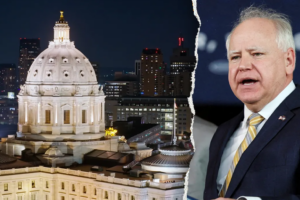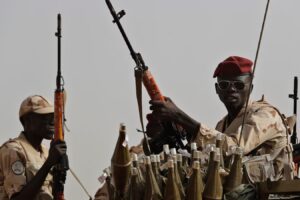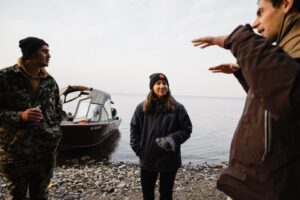
Sitting among a group of fellow Indigenous fire keepers in syilx homelands, Rachel Cavanagh shared knowledge about cultural burns where she is from in Australia.
“Ceremony,” she said, “has such a huge part to play in implementing fire.”
A Minjungbal woman from the Bundjalung/Yugambeh Nation, Cavanagh journeyed more than 12,000 kilometres to attend the inaugural National Indigenous Fire Gathering in snpink’tn (Penticton).
The summit brought together more than 100 Indigenous knowledge holders, leaders and experts from Canada, the United States and Australia between Sept. 23 and 25.
As Cavanagh explained it, the practice of implementing cultural fires year-round is not just about taking care of the landscapes and ecosystems on her nation’s territories — what Indigenous Peoples in her homeland call “Country.”
“It is about our medicines,” she said. “It is about the right type of smoke that is actually really healing for the body.”
“We use it to welcome our babies onto Country. We use it to say goodbye to our Elders as they transition through. We use it for all manner of different things.”
Rachel Cavanagh (second from right), a Minjungbal woman from the Bundjalung/Yugambeh Nation, brought insights on cultural burning from Australia to syilx homelands in September. “We still struggle to access our land,” she said.
Having Elders out on Country during cultural burns — whether they’re implementing fire themselves, or telling stories and dancing — is key.
“It’s that intergenerational transfer of knowledge,” she emphasized. “It’s the sharing and storytelling that comes with practicing our culture and doing what we’re doing.”
As a member of the cultural fire movement, she said Indigenous fire practitioners are pushing for Australian governments to recognize them as “traditional custodians” of their territories.
“We still struggle to access our land,” she said.
Her message was far from unique to the Southern Hemisphere. It resonated with — and echoed — the experiences of many other Indigenous fire experts at the gathering.
A renewed need for cultural burns
September’s gathering in snpink’tn came roughly five years after an earlier meeting of Indigenous representatives from nations across Canada.
At that earlier event, attendees had raised alarms about “how sick the land was,” because its forests were no longer being maintained appropriately, leading to a thick overgrowth of vegetation and woody debris.
They warned this was fuelling the severity of fires, urging Western governments not to ignore the risk any longer.
“It was a really great gathering of like-minded people that are interested in cultural burning — how Indigenous people want to be able to look after the land again,” said Joe Gilchrist, an Indigenous fire keeper from the Skeetchestn Indian Band, a Secwépemc community west of Kamloops.
“Everything was causing pressure for us as Indigenous people to raise our voices and say, ‘We have a way to save communities … with cultural burning and Indigenous land stewardship.’ ”
Cultural burning — also called prescribed, controlled or traditional burning — has been used by Indigenous Peoples for millennia, to manage the health of forests and ecosystems and reduce wildfire risk.
Before settler colonialism, Indigenous nations across the continent regularly conducted low-intensity controlled burns, carefully planned to maintain and replenish the health of the land and its ecosystems.
This ancient method of burning forests and grasslands — using what are today known as prescribed, controlled, cultural or traditional burns — encouraged particular plants and medicines to grow, while also preventing forest overgrowth.
Those practices limited the threat of devastating wildfires blazing out of control.
In the valleys, Secwépemc people conducted early burns in the spring, Gilchrist explained; in the fall, they repeated the practice in the mountains.
“Early spring was for our medicine down below in the grasslands,” he added, “and up high was for our higher elevation medicine areas, food for the animals to eat.”
But while Secwépemc people saw fire as a medicine, settlers gradually removed it from their ecosystems, suppressing it as a problem to be fought.
Settlers favoured logging over maintaining forest health. As reactionary approaches to fighting wildfires became conventional, they led to more debris accumulating in the country’s forests — ironically, leading to even more devastating wildfires today.
Indigenous fire keepers see directly how bad today’s wildfires have become — “how bad the losses are, evacuations, all that kind of stuff,” said Gilchrist.
But they also see something more positive in their communities.
“How much people just love the land, the animals, the fish, the air we breathe, the water,” he said. “How fire is essential to all of that.”
‘Breaking down those challenges and barriers’
As they gathered in snpink’tn, Indigenous experts from around the world discussed ways they have been using fire to steward their homelands for generations.
They also highlighted bureaucratic barriers impeding their ability to do so.
The similarities between different First Nations’ approaches — and colonial resistance to them — were numerous.
“People are interested in collaborating and networking, to see what other people are doing,” said Charlene John, a member of the Tsal’alh First Nation, a St’at’imc community west of Lillooet.
John chairs the Thunderbird Collective’s steering committee, which organized the three-day gathering.
One of the meeting’s goals, she said, was for Indigenous communities to share strategies to overcome the various longstanding barriers that exist to cultural burning.
“Then, the Thunderbird Collective can start working toward breaking down those challenges and barriers, by providing resources or tools, or linking people in networks,” she said.
Common issues highlighted by Indigenous participants at the gathering included regulatory and permitting challenges around conducting cultural burns.
Charlene (Char) John, a member of the Tsal’alh First Nation and chair of the Thunderbird Collective steering committee, said one of the National Indigenous Fire Gathering’s goals was to share strategies to overcome the longstanding barriers to cultural burning.
A growing number of First Nations communities want to be included in improving their landscapes through cultural burning, John said, “and how that creates safer environments from wildfire.”
Cultural burning also requires removing barriers to Indigenous communities participating in responding to wildfires, too.
To John, that means creating First Nations structures parallel to Western governments’ incident-command wildfire-fighting agencies, “to be able to initiate how the fire should be put out, to be able to have that say,” she added.
“Not only here, but many First Nations people wish to advance and wish to seek the rights and authority to assert themselves in [fire] scenarios.”
Hearing these concerns is crucial, as it helps provide the collective with a framework on “how to solve those issues, eventually, as we develop and regrow,” John noted.
But it’s not just about creating greater access to cultural burning for Indigenous communities — it’s about land stewardship.
Or, as John puts it, “seeing the resilience brought back.”
To achieve that, she described “four pillars” of the movement: knowledge-sharing, advocacy, land-based cultural practices and sovereignty.
“These types of gatherings are going to help drive us to what we’re doing in our four pillars,” she said.
“As we develop, we can also grow and help fill those gaps that people are still seeing in the different systems.”
Supporting ‘practices that Indigenous people want in the fire world’
Before the Thunderbird Collective arose from a 2024 naming ceremony in Tk’emlúps (Kamloops), the group was called the National Indigenous Wildfire Management Working Group.
Last month’s gathering was the federally funded group’s first formal gathering under its new name.
“Our goal is to grow and develop,” John said, “and move beyond the federal funding.”
The Indigenous-led organization is “restoring the sacred relationship between fire, land and people,” she explained, “cultivating healthy landscapes, resilient communities and multigenerational learning.”
The steering committee consists of nine Indigenous people from different nations across Canada — many of whom are fire keepers and specialists who participate in and promote cultural burning around the world.
“That’s a big part of why they’re here,” John said. “To support cultural burning, to support all the practices that Indigenous people want in the fire world.”
Joe Gilchrist (second from right), a Secwépemc fire keeper, has been fighting fires since he was 15, and has seen the impact cultural burning can have on mitigating out-of-control wildfires.
One of those specialists is Secwépemc fire keeper Gilchrist, who is the steering committee’s vice-chair. Gilchrist started fighting fires when he was just 15.
He led the Merritt Unit Fire Crew from 1991 to 1996, before finishing his firefighting career with BC Wildfire Service in the early 2010s.
“Now, I travel around and I spread the word about cultural burning and Indigenous land stewardship,” he said.
That work has taken him to Australia, Fiji, Aotearoa (New Zealand), Colombia and United Nations meetings in Rome to promote cultural burning and land stewardship. In his travels, he’s met many Indigenous Peoples who share and advocate for those same values.
Later this month, he’ll be taking his message to COP30 in Brazil, for the 2025 United Nations climate change conference.
“Just all over the world they say the exact same thing as we do — about our love for the land, our love for our animals and our water,” he said.
“Fire was used … all around the globe.”
Keeping Indigenous fire traditions alive isn’t just about caring for the land and preventing out-of-control wildfires, however.
Co-ordinating with other communities on the issue is also helping assert Indigenous sovereignty, “upholding our jurisdiction, and practicing our rights,” Justin Kane, chief of Ts’kw’aylaxw First Nation and a member of the Thunderbird Collective’s steering committee, said.
‘This work is a part of our assertion of sovereignty’
On the gathering’s first day, both regional and international Indigenous communities spoke of the different ways that they use fire to manage their territory — work that correlates to exercising title and sovereignty over their land.
In sməlqmíx (Similkameen)-syilx territory, Lauren Terbasket of the Lower Similkameen Indian Band said managing her people’s territories through fire and water diversion is a way of asserting “title and rights.”
“We believe that this work is a part of our assertion of sovereignty on the land,” she added.
Continuing to use traditional and ancient management practices, such as cultural burns, is a way to prove her nation’s “ongoing use and occupation,” Terbasket said.
“It’s not just a matter of making partnerships, although that’s what we do — it is our way of asserting our title, our jurisdiction and our rights on our own lands.”
In 2018, the band conducted a prescribed burn in the Crater Creek area with BC Wildfire Service and other government agencies.
This area is located within the Ashnola Corridor, which was designated as an Indigenous Protected and Conserved Area in 2022.
When the Crater Creek wildfire swept through the area in 2023, burning more than 40,000 hectares of land, Terbasket said it exhibited “high intensity burning right until it hit the edge of our traditional burned area.”
But many homes located on different reserves throughout the community were not touched by the fire, she recalled.
“We and our Elders believe that it’s because we continue to exercise our responsibility to the land,” she said.
The band is now in the middle of a multi-year prescribed burn project to the akɬʕpas (Place of the Nighthawk) area, with phase one seeing 40 of 370 hectares treated last spring.
“It was really in response to habitat degradation — it was an area that was completely overgrown with sage brush,” Terbasket said.
“Nothing else was growing there. Our traditional foods were no longer growing.”
Without fires ‘our homes become tinder boxes’
Similarly, Margo Robbins, of the Yurok Tribe in California, said her culture also depends on fire.
Fire helps them in many ways, she explained — regularly burning the landscape helps foster medicines and traditional food sources, and also encourages the growth of plants used for basket-making.
“Before we started burning, you’d seldom see a deer on the reservation,” said Robbins, co-founder and executive director of the Cultural Fire Management Council.
She described her community’s young men leaving their reservation — sometimes risking heavy fines — to bring deer meat home to feed their families.
“Now,” Robbins said, “they just go to the places where we burn.”
Fire also impacts her community’s water quality, she said.
“When we burn and leave the charcoal on the landscape, it filters the water, making it more pure,” she explained.
“Also, it reduces the amount of vegetation on the land, [creating] more water flow to the creeks, which flows to the rivers.”
Most important, the community’s use of prescribed and cultural burning also helps prevent out-of-control wildfires.
“One of the few things that impacts the spread and intensity of wildfire is where the place has already been burned,” she said.
“In the absence of fire, our homes become tinder boxes.”
‘Let’s take our place in the ecosystem’
It’s only been 12 years since the Yurok people reclaimed their right to do cultural burns.
Robbins said her grandchildren have never known a world where their community did not manage fire on their territories.
“It’s really an ambition to be putting fire on the ground,” she explained, “to help create the enabling conditions for not only us to burn, but for others to burn also.”
She is part of several groups who meet together to influence state policy and guide legislation.
In 2021, California created a prescribed fire liability fund “to support and expand private prescribed fires throughout the state,” budgeting US$20 million (C$28 million) for the initiative.
Cultural burning is not only a means of protecting forests and land, but of asserting Indigenous sovereignty. Gatherings that unite Indigenous people internationally and regionally can help support this goal through knowledge-sharing.
She believes it’s “our responsibility as humans” to help take care of the land with fire.
“We can’t just rely on lightning strikes to do it,” she said. “We are part of the ecosystem. We need to step up.”
She hopes more Indigenous Peoples learn to reconnect with traditions that “use fire safely” again.
“Let’s take our place in the ecosystem to restore it to help.”
One strategy the community undertook was to get everyone involved in encouraging family burns. Robbins explained this approach was the Yurok’s “traditional way of burning” — families “out burning around their homes and gathering places, at the right place at the right time,” she said.
They also offer “aspiring firefighter workshops” for “people that have never worked with fire that want to learn how,” she said.
“It’s my belief that everybody should have the right to use fire. We used to have that right. We used to do that, and our landscapes looked a lot better.”
‘We do it the way we want to do it’
Seven participants represented First Nations in Australia at the gathering, where they offered insight into their people’s relationship with fire and how they use it on their homelands.
“In different places, during certain climates, we’ll burn for plants, for animals,” Deborah Swan, a Ngarrindjeri imimini (woman), said.
“We never use fuel. To us, that’s another contamination to soil and the Earth. We use natural fibers and things like fire sticks.”
Certain fire sticks are used depending on a burn’s objectives — for instance, what kind of plants or other resources a fire keeper is hoping will regenerate afterwards.
She noted her community comes across different government legislation that is “trying to take our knowledge” without actually respecting Indigenous Peoples leading the work.
“Sometimes, we’re being put to the side,” she said. “Or they’re still using fuel, or still telling us when we can burn.”
She believes the fire traditions must be maintained “to keep our women strong, and know that they’re supported to continue their practices.”
Cultural burns, she said, are still “very much a community burn.”
“The children are there,” she explained. “You can walk around barefeet if you want to.”
When it comes to cultural burning on Crown land, Cavanagh said Australian federal and state governments claim they want to include First Nations’ voices in fire legislation and create opportunities for them.
But that inclusion happens on settlers’ terms, “under their prescriptions,” she said — with government telling Indigenous Peoples rules such as, “You must do this training” or “You have to wear a hat, you got to wear shoes, you got to do all these things.”
But cultural fire on Country is easy for her community when it’s on their private lands, she said.
“We do it the way we want to do it. It is actually us leading and having a say on what that looks like. That’s the important thing.”
Fire as a source of Indigenous healing
Cassandra McKechnie — who is Wiradjuri, Taepadthigi, Kulkagal, Saibailaig and Erubian — said the cultural fire space has become a source of healing for Indigenous Peoples in Australia.
“You see the impact it has on Country and everything that lives within Country, and that extends to us as well,” McKechnie said.
“I started to feel that in myself and in my spirit.”
Rhys Pacey, a Waagay cultural burn practitioner and the chief fire practitioner with Yurruungga Aboriginal Corporation, said the beauty of cultural burning is also in all the relationships it builds — not just with the community and its children, but with the land itself.
That includes interacting with wildlife, trees and other plants, Pacey said.
Once a cultural fire is started, and its smoke begins to appear, “You just see the way everything reacts,” he explained. “Then you stop and you use all your senses. You just immerse yourself. It’s repairing.”
Dean Thomas Kelly, chief executive officer of Yurruungga Aboriginal Corporation, described himself as “a proud Gumbaynggirr custodian.”
Kelly said gatherings of Indigenous Peoples — like the one in snpink’tn last month — help him realize “we haven’t lost anything when we come together.”
“And I think that is the most beautiful journey I have been on.”





